
The Knowledge Economy:

| The Knowledge Economy: Is the United States loosing its competitive edge? by Task Force on the Future of American Innovation “The Task Force on the Future of American Innovation has developed a set of benchmarks to assess the international standing of the United States in science and technology. These benchmarks in education, the science and engineering (S&E) workforce, scientific knowledge, innovation, investment and high-tech economic output reveal troubling trends across the research and development (R&D) spectrum. The United States still leads the world in research and discovery, but our advantage is rapidly eroding, and our global competitors may soon overtake us.” Introduction For more than half a century, the United States has led the world in scientific discovery and innovation. It has been a beacon, drawing the best scientists to its educational institutions, industries and laboratories from around the globe. However, in today’s rapidly evolving competitive world, the United States can no longer take its supremacy for granted. Nations from Europe to Eastern Asia are on a fast track to pass the United States in scientific excellence and technological innovation. The Task Force on the Future of American Innovation has developed a set of benchmarks to assess the international standing of the United States in science and technology. These benchmarks in education, the science and engineering (S&E) workforce, scientific knowledge, innovation, investment and high-tech economic output reveal troubling trends across the research and development (R&D) spectrum. The United States still leads the world in research and discovery, but our advantage is rapidly eroding, and our global competitors may soon overtake us. Research, education, the technical workforce, scientific discovery, innovation and economic growth are intertwined. To remain competitive on the global stage, we must ensure that each remains vigorous and healthy. That requires sustained investments and informed policies. Federal support of science and engineering research in universities and national laboratories has been key to America’s prosperity for more than half a century. A robust educational system to support and train the best U.S. scientists and engineers and to attract outstanding students from other nations is essential for producing a world-class workforce and enabling the R&D enterprise it underpins. But in recent years federal investments in the physical sciences, math and engineering have not kept pace with the demands of a knowledge economy, declining sharply as a percentage of the gross domestic product. This has placed future innovation and our economic competitiveness at risk. To help policymakers and others assess U.S. high-tech competitiveness and the health of the American science and engineering enterprise, we have identified key benchmarks in six essential areas – education, the workforce, knowledge creation and new ideas, R&D investments, the high-tech economy, and specific high-tech sectors. We conclude that although the United States still leads the world in research and discovery, our advantage is eroding rapidly as other countries commit significant resources to enhance their own innovative capabilities. The Task Force on the Future of American Innovation, a coalition of high-tech companies, business organizations, scientific societies, and higher education associations, was founded in 2004 to advocate greater federal investments for basic research in the physical sciences and engineering. The group focuses specifically on the National Science Foundation, the Department of Energy Office of Science, the Department of Defense research budget, and the National Institute of Standards and Technology labs at the Department of Commerce. Its members are: Agilent Technologies, AeA, ASTRA, American Chemical Society, American Mathematical Society, American Physical Society, Association of American Universities, Computing Research Association, Computing Technology Industry Association, Computing Systems Policy Project, Council on Competitiveness, Hewlett-Packard, Intel, Lucent, Materials Research Society, Microsoft, National Association of Manufacturers, NASULGC, The Science Coalition, Semiconductor Industry Association, Southeastern Universities Research Association, and Texas Instruments. |
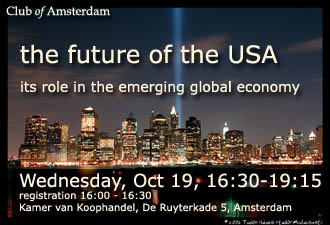
News about the future of the USA

Monitoring the Future
Monitoring the Future is an ongoing study of the behaviors, attitudes, and values of American secondary school students, college students, and young adults. Each year, a total of some 50,000 8th, 10th and 12th grade students are surveyed (12th graders since 1975, and 8th and 10th graders since 1991). In addition, annual follow-up questionnaires are mailed to a sample of each graduating class for a number of years after their initial participation.

The Media: More Voices, Less Credibility
by The Pew Research Center for the People and the Press
Changing demographics, lifestyles, business trends and, most of all, technologies have fundamentally altered the way we get the news. No single source today is nearly as dominant as network news was in the early 1990s. News consumers can choose from an expanding menu of options — print and electronic, network and cable, digital and analog. This has led to declining audiences for many traditional news sources and has changed the nature of competition among news outlets, from a set-piece battle among a handful of rivals to an all-out scramble for survival.
As the media landscape has shifted, so too have the public’s news tastes and preferences. Sitting down with the news on a set schedule has become a thing of the past for many time-pressured Americans; instead, they graze on the news throughout the day. More people are turning away from traditional news outlets, with their decorous, just-the-facts aspirations to objectivity, toward noisier hybrid formats that aggressively fuse news with opinion or entertainment, or both. Young people, in particular, are bypassing mainstream sources in favor of alternatives they find on the internet or late-night television.
News about the future

Psychologists find that two different thought processes can explain how we gauge our risk of disease
Psychologists have gained insight into how people judge their personal health risks. The findings suggest that people aren’t horribly off the mark as long as they do not rely on media reports and stick to what’s happened to people they know.
The findings challenge the assumption, says Ralph Hertwig, PhD, of the University of Basel in Switzerland, that people make huge blunders when inferring the likelihood of, say, dying of a heart attack or in a car accident. He says, “People can arrive at relatively accurate estimates as long as they rely on their personal experiences of the frequencies of such events … by thinking of how many of their relatives, friends and acquaintances died from these causes.”
He continues, “However, when they start sampling from the virtual world as created by the mass media, they are more likely to arrive at distorted estimates of likelihood.” For instance, if people sample from the virtual world, they might readily conclude that many more people die due to more rare but dramatic causes such as mad-cow disease or airplane crashes, than due to more typical causes such as asthma.
The authors are concerned that as “factors such as overpopulation, poverty, and global climate change pave the way for new health risks, it becomes even more important to better understand how the public perceives and judges risks.”

The Coming Demographic Deficit: How Aging Populations Will Reduce Global Savings
by McKinsey Global Institute
The long-term solvency of pension plans – both public and private – is a growing concern across the developed world as policy-makers wrestle with the fiscal consequences of aging, and business leaders and investors seek to understand how aging will affect global markets for goods, capital and labor. The answer to all these issues depends largely on a fundamental question that is often overlooked: How will aging affect future levels of household wealth and economic well-being? New research by the McKinsey Global Institute (MGI) sheds light on this question, drawing its conclusions from in-depth analyses of five countries – the U.S., Japan, Germany, Italy, and the U.K.– which together account for two-thirds of global financial assets.
Birth rates will fall and lifespans will continue to lengthen over the next two decades, driving up the median ages in many countries. In Japan, for example, the median age will rise from 43 to 50, and from 42 to 51 in Italy. MGI’s new report reveals that the aging of the developed world is creating a demographic deficit that could radically transform the financial wealth of households, and therefore, the capital available to businesses and government.
MGI’s key finding is that over the next two decades, absent dramatic changes in saving behavior or returns earned on financial assets, growth in household financial wealth will slow by more than two-thirds, from 4.5 percent historically to 1.3 percent going forward. This slowdown will cause the level of household financial wealth to fall some 36 percent, or approximately $31 trillion, below what it would have been had the higher historical growth rates persisted.
The U.S. will be by far the largest source of the global shortfall ($19 trillion) because of the U.S. dominant share of global financial wealth. Japan stands out as the second-largest source ($8 trillion) of the global shortfall, because its demographic trends are so severe. MGI projects that Japan’s household financial wealth will stop growing and enter an absolute decline over the next two decades, driving a 47 percent shortfall in wealth.
Next Event: Wednesday, October 19, 16:30-19:15

the future of the USA– its role in the emerging global economy
Wednesday, October 19, 2005
Registration: 16:00-16:30, Conference: 16:30-19:15
Where: Kamer van Koophandel Amsterdam – Netherlands Chamber of Commerce, De Ruyterkade 5, 1013 AA Amsterdam
With
Richard Huss, Economic Counselor, U.S. Embassy: The future role of the United States in the global economy
Hans R. Langeveld, Managing Partner, Maes & Lunau Executive Search
Peter R. Luiks, CEO, Asian Centre for Consulting Excellence: From world dominance to world leadership
and our Moderator Homme Heida, Promedia, Member of the Club of Amsterdam Round Table
Science Museum London
The origins of the Science Museum lie in the nineteenth-century movement to improve scientific and technical education. Prince Albert was a leading figure in this movement, and he was primarily responsible for the Great Exhibition of 1851 to promote the achievements of science and technology. The profits of the hugely successful Exhibition were used to purchase land in South Kensington to establish institutions devoted to the promotion and improvement of industrial technology. At the same time, the Government set up a Science & Art Department which established the South Kensington Museum in 1857, from which the Science Museum and Victoria & Albert Museum have developed.
The objects on display in the South Kensington Museum were drawn from various sources including the Great Exhibition. Most were art objects, but the ‘science collections’, as they were known, included models, apparatus, examples of materials, books and educational resources. The collections were boosted by an international exhibition in 1876 of scientific instruments. In 1884 the Patent Museum passed on its stock of patent models to the science collections, including priceless objects such as Stephenson’s ‘Rocket’ and Arkwright’s original textile machinery. The arts and science collections gradually assumed their own identities to the extent that the Science Museum and the Victoria & Albert Museum were formally separated in 1909. A new building to house the Science Museum was formally opened by King George V in 1928. The Museum continued to expand its premises and its collections. In the early 1980s, objects from the Wellcome collection were placed on permanent display.
In the 1980ies a period of rapid expansion started: New interactive galleries, such as Launch Pad and Flight Lab, were opened, supplementary exhibitions were initiated and the Museum developed a busy programme of activities and events. New Galleries in 1996 included the imaginative “Secret Life of the Home” and extensive new hands-on education facilities.
Online Exhibitions and Interactives
Discover more about science, scientific people and events through our collections of exhibitions and interactives.
Some examples:
 | Antenna Antenna is a world first – a constantly-updated exhibition devoted exclusively to science and technology news. It’s the place to get up to date. |
 | Energy – fuelling the future Play Energy Ninjas, test yourself with our online quizzes and find out more about the Science Museum’s newest gallery. |
 | Ingenious Ingenious is a new website with over 30,000 museum images making connections between people, innovations and ideas. |
 | Your Lifecycle Find Out More You started life as a cell, smaller than a pin-prick. This divided into two, then four, then eight – and so on. Your whole body is now made up of about a 100 million million cells: just one teaspoon of your blood contains about 25 billion red blood cells. |
 | Exploring Leonardo Learn about this fascinating scientist, inventor, and artist. |
Recommended Book
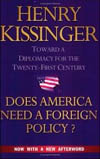
Does America Need a Foreign Policy? Toward a Diplomacy for the 21st Century
by Henry Kissinger
Former Secretary of State Henry Kissinger asks a question in the title of his book Does America Need a Foreign Policy?–but there’s really no doubt about the answer. That’s not to say it shouldn’t be asked: “The last presidential election was the third in a row in which foreign policy was not seriously discussed by the candidates,” writes Kissinger. “In the face of perhaps the most profound and widespread upheavals the world has ever seen, [the United States] has failed to develop concepts relevant to the emerging realities.” Kissinger tours the world in this book, describing how the United States should relate to various regions and countries. This is not a gripping book, but it is sober, accessible, brief, and comprehensive–and an excellent introduction to international relations and diplomacy.
Kissinger has opinions on just about every topic he raises, from globalization (for it) to international courts (against them, for the most part). He supports a vigorous missile-defense system: “The United States cannot condemn its population to permanent vulnerability.” He opines on peace in the Middle East: “Israel should abandon its opposition to the creation of a Palestinian state except as part of a final status agreement.” His claims are often eye-opening: “There are few nations in the world with which the United States has less reason to quarrel or more compatible interests than Iran.” He is especially critical of domestic politics interfering with America’s international relations: “Whatever the merit of the individual legislative actions, their cumulative effect drives American foreign policy toward unilateral and seemingly bullying conduct.” The media has been a special problem in this regard, as it zips around the world in search of exciting but ephemeral stories, which are “generally presented as a morality play between good and evil having a specific outcome and rarely in terms of the long-range challenges of history.” Does America need a foreign policy? Of course it does, and Henry Kissinger has done readers a service by outlining what a good one might be. – John J. Miller
| GlobalSourcingNOW |
GlobalSourcingNOW is a FREE daily and weekly newsletter providing the latest updates on the global offshoring and outsourcing industry. GlobalSourcingNOW is hosted by Evalueserve, a leading provider of expert knowledge services. Industries such as Information Technology, Human Resource Management, Finance & Insurance, Knowledge Management, Customer Relationship Management, Biotechnology, Engineering, and Research & Development are extensively researched and covered by GlobalSourcingNOW. GlobalSourcingNOW newsletters reach over 22,000 subscribers across 40 countries. For further details on this, please refer to this link: http://www.globalsourcingnow.com |
Mayo Clinic Creates “Office of the Future”
Mayo Clinic Creates “Office of the Future”
Lose weight while you work
The creator of the “Office of the Future” is quick to correct them.
“This is a fully functioning office. My entire staff works here,” explains James Levine, M.D., as he walks on a moving treadmill that serves as both desk and computer platform. “The idea is to introduce an environment that will encourage activity in the workplace. Just as it’s hard to be a couch potato without a couch, it’s hard to sit all day at work without a chair or a conventional desk or cubicle.
“We have meeting rooms, but for small groups we prefer the track,” says Dr. Levine. He’s referring to a two-lane walking track that circles most of the 5,000-square-foot floor. “So when my colleagues and I ‘take a meeting’ we also take a walk.”
This scientifically designed office environment is the practical realization of a decade of research at Mayo Clinic. Dr. Levine, an endocrinologist, has spent his career studying how humans expend energy. His recent research findings (Science, Jan. 27, 2005) show that genomic and biological differences impact how many calories a person burns during everyday tasks. It proved the long-discussed concept of a “slow metabolism” as a factor in obesity. It also showed that people can increase their caloric “burn rates” by integrating more movement into their daily regime. Dr. Levine calls this process “non-exercise activity thermogenesis” (NEAT).
The room makeover cost about $5 per square foot. The standing desks cost about $1,000 each, but the room requires no other office furnishings, and no cubicles. The result: a traditional office floor is transformed into a clean, sunny, open space with 10 Plexiglas standing computer desks, complete with variable-speed treadmills. There are no desk phones or wall phones. All employees wear mobile phones on their belts along with a Mayo-designed standometer that measures their vertical time and recognizes when they sit down. It also tells them how much more activity they need in order to meet their individual activity goals for the day. (They might need to take one more meeting.)
- Walls near the track are essentially magnetic white boards (instead of fabric) for posting ideas and scribbling notes during the moving meetings.
- Animated art projections are seen on at least three walls to reinforce the concept of activity.
- Employees can strap on plastic carpet skates, and slide from meeting to meeting for a change of pace.
- All keyboarding, phoning and thinking are done during some form of motion.
- Coffee and healthy snacks are available nearby, but staff must walk to get them
Club of Amsterdam Agenda
| NEW: .Our Season Events are Wednesdays 16:30! | |
| 16:00-16:30 Registration 16:30-17:45 Part I: Presentations 17:45-18:15 Break: Drinks and evtl. live music 18:15-19:15 Part II: Discussion | |
| Club of Amsterdam Season Events 2005/2006 | |
| .Oct 19 | the future of the USA |
| .Nov 30 | the future of Software Architecture |
| .Jan 25 | the future of Futurist Tools |
| .Mar 1 | the future of Electronic Identity |
| .Mar 29 | the future of Governance |
| .Apr 26 | the future of Drugs & Pharma |
| .May 31 | the future of Reputation Management |
| .Jun 28 | the future of Journalism / Ethics in Journalism |

Club of Amsterdam Open Business Club
| |
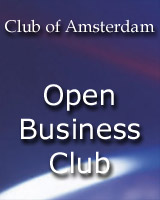


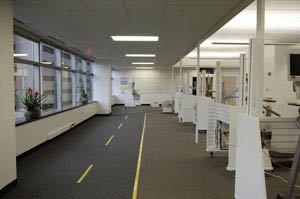
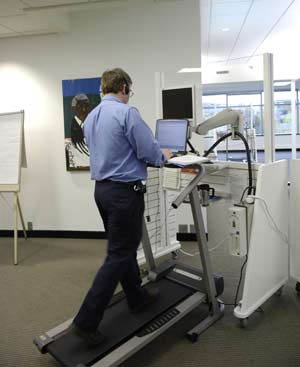


Customer Reviews
Thanks for submitting your comment!